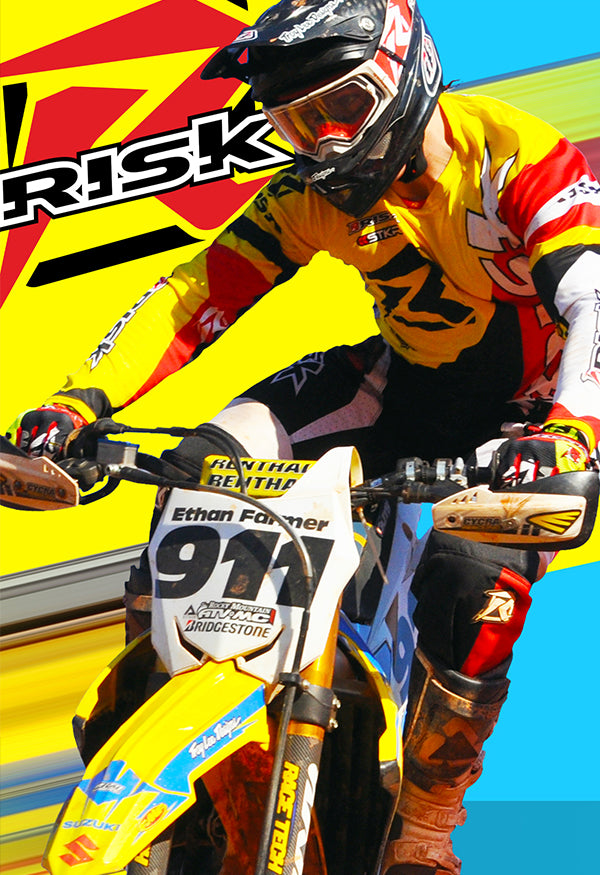Your Cart is Empty
MOTO Products
shop your way
Choose a shopping experience
Same great Risk Racing products, 3 completly different ways to shop them.
Choose a shopping experience
Same great Risk Racing products, 3 completly different ways to shop them.

Lifestyle Shopping

eComm Shopping

Catalog Shopping
MOTO TYRES
MOTO Gear & Apparel
How Does the Point System Work In Supercross?
March 04, 2021 5 min read

Supercross has undergone many changes over the years, the most important of which is the new points system instituted in 2018. For both long-time fans of the sport as well as newcomers, these changes can be confusing.
Supercross points are awarded to racers who complete the track with a maximum of 26 points for first place, all the way down to 1 point for last place. This new system still provides a significant advantage to winners while reducing the punishment for individual nights' inconsistent performances.
This explanation covers only the basics of the point system in supercross. We're going to break down all the details of how points scoring works so that you will be primed and ready to watch and support your favorite racers!
Supercross Points Breakdown
As you might expect from any form of racing, the riders with the fastest times are the ones who earn the most points. The exact breakdown of how the points are distributed is illustrated below.
|
1st Place - 26 Points |
12th Place - 11 Points |
|
2nd Place - 23 Points |
13th Place - 10 Points |
|
3rd Place - 21 Points |
14th Place - 9 Points |
|
4th Place - 19 Points |
15th Place - 8 Points |
|
5th Place - 18 Points |
16th Place - 7 Points |
|
6th Place - 17 Points |
17th Place - 6 Points |
|
7th Place - 16 Points |
18th Place - 5 Points |
|
8th Place - 15 Points |
19th Place - 4 Points |
|
9th Place - 14 Points |
20th Place - 3 Points |
|
10th Place - 13 Points |
21st Place - 2 Points |
|
11th Place - 12 Points |
22nd Place - 1 Point |
This system is a modification to the original point system for supercross events used for two decades. The main difference is an increase between one and two points for most positions on the end score. This change's goal was to create a more linear spread of the point totals, which means that the best racer with the fastest time will still earn the most points. Yet, inconsistent performances will be slightly less punishing than they were under the previous scoring system.
This new system also means that winning will be slightly more challenging than it was before. With a narrower spread between results, it creates more opportunities for racers to come from behind if they are able to secure higher placed finishes.
250SX and 450SX Classes
In order to understand the format of supercross, it's essential to learn about the different classes that compete. Two primary divisions race in supercross events, the 250SX and the 450SX, which differ in a couple of ways. The absolute top riders race in the 450SX class, where they ride 450cc four-stroke motorcycles. This class is dominated by many of the most notable names in supercross, including Eli Tomac, Cooper Webb, Ken Roczen, and Adam Cianciarulo.
The 250SX class is geared towards younger and newer riders who race on 250cc four-stroke motorcycles and are further separated into east and west regions, which have their own qualifying rounds. Each of these regions will crown its own champion, and they only meet to compete against each other in the final race of the season, which has taken place in Salt Lake City, Utah the past two seasons.
The numbers 250 and 450 in the class divisions refer to the actual engine sizes of the bikes involved, which uses cubic centimeters of displacement for measurement. This boils down to 450 class motorcycles having more power and torque than their smaller cousins, but they are also heavier and more difficult to control. What may surprise some people is that the lap times between the two different classes are actually reasonably similar. However, in a race between bikes of each class, the 450s will outpace the 250s out of the gate and when accelerating out of turns.
How Does Qualifying Work in Supercross?
We have established at this point that racers earn points based on their placements in the qualifying rounds, but to grasp how the point system in supercross works, we have to take a closer look at the way qualifications function. To begin with, there are always more riders than there are available spots to race in the finals. With only 22 available spots in the starting gate, shaving down the competition is an essential aspect of the sport.
The racers start by taking part in three practice sessions, the first of which is an untimed practice round, the second and third of which are both timed. Each rider's lap times are recorded via electronic transponders in the second and third rounds, and when the practice ends, the top 40 racers in each class (250SX and 450SX) advance to the evening round.
Next, the top 40 riders from the qualifying rounds have to compete in a series of secondary qualifying races to determine who will make it to the main event. The 250SX and the 450SX classes will each have two, 20-person heat races that last for six minutes plus one lap, and the top nine racers from each heat then move on to the final round, the Main Event.
When the riders complete in these last heats, and the 18 racers have made it into the main event, the remaining riders compete against each other in what is referred to as the Last Chance Qualifier (LCQ). The Last Chance Qualifier lives up to its name by only allowing four riders from each class to make it into the final round. This narrow margin for victory coupled with the LCQ only lasting for five minutes plus one lap means that some of the most hard-fought races happen during this round.
Only when all of the qualifying heats and the LCQ are completed does the main event start, which is the portion of the supercross event where the actual points are awarded. The main event lasts for 15 minutes plus one lap for the 250SX class and 20 minutes plus one lap for the 450SX class. Any rider that doesn't make it into the main event is finished for the event and will receive no series points.
The Importance of Winning the Start of a Supercross Race
No matter what part of the event you are in, whether the practice rounds or the main event, one of the single most important aspects of a Supercross race is the beginning of it. If a racer is able to make it out of the starting gate quickly and get a lead on the other racers early, they can often maintain that lead. Even the 20-minute plus one lap main event generally does not provide enough time for a racer in the back to overtake very many others.To learn more about the holeshot see our article here.
To ensure a fair start, all the racers begin by lining up against the gate that guarantees everybody accelerates simultaneously. The higher you place in the qualifying heats, the sooner you get to pick your starting position at the gate. A tremendous amount of strategy and planning goes into this portion of the race and is worth an article of its own!

Crossing the Finish Line
Supercross as a sport has evolved so much over the last couple of years. While it has always been an event that challenges the talent, endurance, and resolve of its competitors, it has now reached a point where the competition is not only fierce but fair as well. Supercross brings excitement and spectacle for a whole day, and with the changes to the point system and the updates to the rules of the sport, it's a better time than ever to get into it!
Leave a comment
Comments will be approved before showing up.
Subscribe
Sign up to get the latest on sales, new releases and more …

Limited Time 10% Off
Save on your 1st order and get email offers when you join.
Eligible for first-time website purchases only. Emails may take a few minutes to process and could get flagged by email providers as junk so be sure to wait a little bit and check your junk and/or spam folders.

 UK/EU▾
UK/EU▾





























